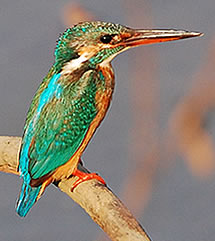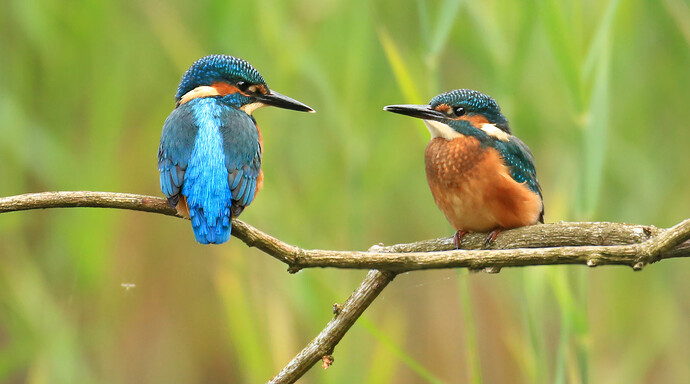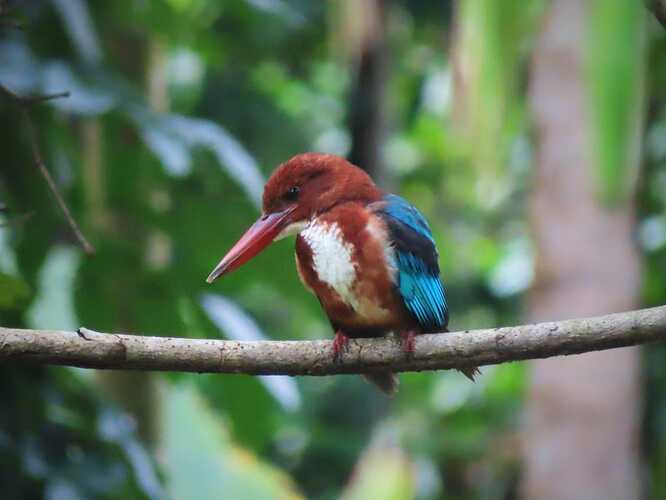This is the white-throated kingfisher ( Halcyon smyrnensis ) or the white-breasted kingfisher.
Location: Ernakulam, Kerala
Date: 8/9/2019
I’ve noticed many kingfishers, including this one, bobbing it’s head on perch. Why do they do this?
Kingfisher adult (left) and juvenile (right)
They close their eyes as they dive into the water, so they are fishing blind! They bob their heads before diving to accurately judge the depth of the fish.
Kingfisher courtship occurs in spring. The male will approach the female with a fish in his beak. He will hold it so that the head of the fish is facing outwards and attempt to feed it to the female. If he is unsuccessful he will simply eat the fish himself. He may have to repeat this feeding behaviour for some time before mating occurs.
Isn’t it interesting!! ![]()
Reference: Eight facts about kingfishers | Scottish Wildlife Trust
What are the distinguishing features seen in Adult and juvenile kingfishers? How do you tell them apart?
@drishtantmkawale
The easiest way to identify a juvenile is to look at it’s feet. From the point that it fledges until it is several months old the juveniles feet are much duller than the bright orange colour of the adult birds. The younger the bird the more mottled (spots or marks of colour) is the appearance of the feet.
Another give away to look out for is the pale tip on the beak of a young bird. It’s been suggested that the pale tip is adapted for life in the burrow so the adult can recognise where the chicks beaks are situated in the poor light inside the burrow. Once they emerge, the pale tip starts to fade, but it’s still clearly visible in birds a couple of months old.
The final things to consider are more general. Youngsters often hang around together and are less shy of people than adults, so if you see 2 or 3 birds in reasonably close proximity to each other, they will probably be juveniles. Their plumage (layers of feathers which protect them) is just a bit duller overall than the adult birds and they appear a bit more compact (dense) in appearance than the adults.
Reference: http://www.wildlifelens.co.uk/2012/07/kingfisher-juv-id/
An interesting observation!!! ![]()
Yes indeed! and yes the study of change in their mating, breeding habits according to their change in habitat will also be interesting to study.
What are the common characteristics of a kingfisher??
Like at the first look at itself how do we say its a kingfisher??
So, as visible in this picture, The Kingfisher Bird can be identified by looking at their Long as well as Pointed Beak, their short stature, their legs are orangish red in colour and they have a bright coloured plumage i.e. feathers which look beautiful while the ![]() is in flight and also, if you look closely, Male kingfishers and female kingfishers are almost identical except for an orange colouration with a black tip on the lower part of the females beak/mandibles (lower jaws).
is in flight and also, if you look closely, Male kingfishers and female kingfishers are almost identical except for an orange colouration with a black tip on the lower part of the females beak/mandibles (lower jaws).
Isn’t this a piece of beauty!!![]()

Reference: https://animalcorner.co.uk/animals/common-kingfisher/
@drishtantmkawale @Lydia What are the different species of kingfishers y’all have observed in your localities?
I’ve spotted the white-breasted kingfisher or Halcyon smynensis;
And the stork-billed kingfisher or Halcyon capensis. Unfortunately, I couldn’t snap a picture of the latter
As most of us don’t know about the specie level identification , can u suggest methods to determine a specie of a bird correctly @Akshitha (any app or reference kind of stuff). This will be greatly helpful to everyone especially to me , @drishtantmkawale and @lydia
For species level bird identification, I find this book by Salim Ali the most helpful —>
The Book of Indian Birds, 13th edition Oxford University Press, 2002.
Salim Ali
ISBN 0195665236
There is an online version of an older edition —>
https://books.google.co.in/books?id=xEq2OgAACAAJ&dq=the+book+of+indian+birds+13th+edition&hl=en&sa=X&ved=0ahUKEwi17a7K3ILkAhWKaCsKHfUHCXAQ6AEICTAA
Google lens is also a great way to get a narrowed idea of what bird species it could be. If you could narrow down just a few morphological features, you’ll easily be able to pinpoint the species in most cases as Aves identification is not as difficult as that of Arthropods.
I hope this helps ![]()
Yeah this could be helpful , yet I don’t know how this book is ,can you please share PDF of this book … awaiting for your help ![]()
To be honest, I have not observed a single kingfisher in my locality. Maybe because of unsuitable climate or factors. They prefer temperate regions i.e. mild climate (cool), and boss, Mumbai is no good for them!!
Kingfishers are found by still or slow flowing water such as lakes, canals and rivers in lowland areas. In winter, some individuals move to estuaries and the coast. Occasionally they may visit suitably sized garden ponds.
Reference: https://animalcorner.co.uk/animals/common-kingfisher/
Great pic!!
Looks like an Adult Male though… orangish beak, coloured legs…
Sure!!!
Haven’t seen any yet…
But would click pics and post it when seen…
We’ll be going through the pictures that you have uploaded here to identify these beautiful birds!!..![]()



